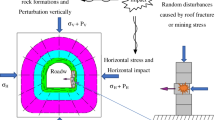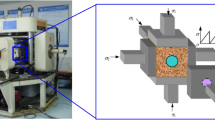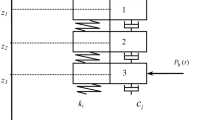Abstract
Zonal disintegration widely exists in the excavation roadways and caverns in deep rock masses. Ultra-low friction can be generated in the deep fractured rock masses, which reduces or disappears under dynamic loading. In this paper, granite blocks were processed into cube specimens with a cylindrical hole in center. Static loads and sinusoidal disturbances were applied to study the sliding phenomenon between blocks. During the experiments, real-time images, and acoustic emissions were recorded. Results indicate blocks above the cylindrical hole slide during the second half of the sinusoidal disturbance, and block sliding is caused by a reduction of friction between the blocks. The existence of ultra-low friction can be inferred from this experiment.









Similar content being viewed by others
References
He MC (2004) Present state and perspective of rock mechanics in deep mining engineering. In: Proceedings of the 8th rock mechanics and engineering conference Chinese Society for Rock Mechanics and Engineering. Science Press, Beijing, pp 88–94 (in Chinese)
He MC, Xie HP, Peng SP et al (2005) Study on rock mechanics in deep mining engineering. Chin J Rock Mech Eng 24(16):2803–2813 (in Chinese)
He MC, Liu DQ, Gong WL et al (2014) Development of a testing system for impact rockbursts. Chin J Rock Mech Eng 33(9):1729–1739 (in Chinese)
He MC, Wang Y, Liu DQ et al (2019) Experimental study on ultra-low friction effect of granite block based on two-dimensional digital image correlation technique. J China Coal Soc 43(10):2732–2740 (in Chinese)
Kurlenya MV, Oparin VN (1999) Problems of nonlinear geomechanics. Part I. J Min Sci 35(3):216–230
Kurlenya MV, Oparin VN (2000) Problems of nonlinear geomechanics. Part II. J Min Sci 36(4):305–326
Kurlenya MV, Adushkin VV, Oparin VN (1992) Alternating reaction of rocks to dynamic action. Doklady ANSSSR Geotech 26(2):323–329
Kurlenya MV, Oparin VN, Vostrikov VI (1997) Ultra-low friction in block media. J Min Sci 33(33):1–11
Kurlenya MV, Oparin VN, Vostrikov VI (1998) Geomechanical conditions for quasi-resonances in geomaterials and block media. J Min Sci 34(5):379–386
Kurlenya MV, Oparin VN, Vostrikov VI (1999) Effect of ultra-low friction in block media. J Appl Mech Tech Phys 40(40):1116–1120
Li LP, Pan YS, Ma SL et al (2008) Experimental research into effect of ultra-low friction of rock mass in deep mining. J Min Saf Eng 25(2):164–167 (in Chinese)
Li LP, Pan YS, Zhang MT (2009) Theoretical analysis of ultra-low friction on rock mass based on simply supported beam model. Chin J Rock Mech Eng 28(S1):2715–2720 (in Chinese)
Li LP, Pan YS, Wang XC et al (2014a) Theoretical analysis of ultra-low friction effect in deep block rock mass considering overlying rock pressure. J Nat Disasters 1:149–154 (in Chinese)
Li LP, Pan YS, Wang XC et al (2014b) Influence analysis of exploit depth and vertical impact load on ultra-low friction rockburst. J Rock Mech Eng S1:3225–3230 (in Chinese)
Li LP, Li WJ, Pan YS (2019) Theoretical analysis of anomalously low friction effect of block rock media based on vertical displacement difference. J China Coal Soc 44(07):2116–2124 (in Chinese)
Li A, Liu Y, Dai F, Liu K, Wei MD (2020) Continuum analysis of the structurally controlled displacements for large-scale underground caverns in bedded rock masses. Tunnel Undergr Space Technol 97:103288
Oparin VN, Balmashnova EG, Vostrikov VI (2001) On dynamic behavior of “self-stressed” block media. Part II: comparison of theoretical and experimental data. J Min Sci 37(5):455–461
Pan YS, Wang KX (2014) Pendulum-type waves theory on the mechanism of ultra-low friction between rock masses. Seismol Geol 36(3):833–844 (in Chinese)
Qian QH (2004a) The current development of nonlinear rock mechanics: the mechanics problems of deep rock mass. In: Proceedings of the 8th national conference on rock mechanics and engineering. Science Press, Beijing, pp 10–17 (in Chinese)
Qian QH (2004b) The characteristic scientific phenomena of engineering response to deep rock mass and the implication of deepness. J East China Inst Technol 27(1):1–5 (in Chinese)
Qian QH (2004c) The key problems of underground space development in deep. In: The key technical problems of base research in deep underground space development the 230th Xiangshan science conference. Beijing (in Chinese)
Qin Z, Fu HL, Chen X (2019) A study on altered granite meso-damage mechanisms due to water invasion-water loss cycles. Environ Earth Sci 78:428
Wang MY, Qi CZ, Qian QH (2005) Study on deformation and motion characteristics of blocks in deep rock mass. Chin J Rock Mech Eng 24(16):2825–2830 (in Chinese)
Wang HL, Tao Ge, Wang DR et al (2007) On the theory and experiment of the dynamic characteristics of block rock mass. Chin J Rock Mech Eng 26(5):2825–2830 (in Chinese)
Wang DR, Lu YS, Feng SF, Wang M (2008) The develop to multi-functional test system of deep level rock body dynamic specialty. Chin J Rock Mech Eng 27(3):601–606 (in Chinese)
Wang J, Li SC, Li LP et al (2019) Attribute recognition model for risk assessment of water inrush. Bull Eng Geol Environ 78(2):1057–1071
Wu H, Fang Q, Wang HL (2008) Advances in the study on pendulum-type wave phenomenon in the deep block rock mass. Adv Mech 38(5):601–609
Wu N, Liang ZZ, Zhou JR, Zhang YZ (2020) Energy evolution characteristics of coal specimens with preformed holes under uniaxial compression. Geomech Eng 20(1):55–66
Xu QP, Lu YS, Wang DR (2009) Experimental study on friction weakened effect of deep block rock mass. J PLA Univ Sci Technol Nat Sci 10(3):951–958 (in Chinese)
Acknowledgements
This work is supported by the National Natural Science Foundation of China (No. 51704298).
Author information
Authors and Affiliations
Corresponding author
Additional information
Publisher's Note
Springer Nature remains neutral with regard to jurisdictional claims in published maps and institutional affiliations.
Rights and permissions
About this article
Cite this article
Liu, D., Lin, Y., Wang, Y. et al. Experimental Study on Ultra-low Friction Effect of Granite Block Under Coupled Static and Dynamic Loads. Geotech Geol Eng 38, 4521–4528 (2020). https://doi.org/10.1007/s10706-020-01306-5
Received:
Accepted:
Published:
Issue Date:
DOI: https://doi.org/10.1007/s10706-020-01306-5




